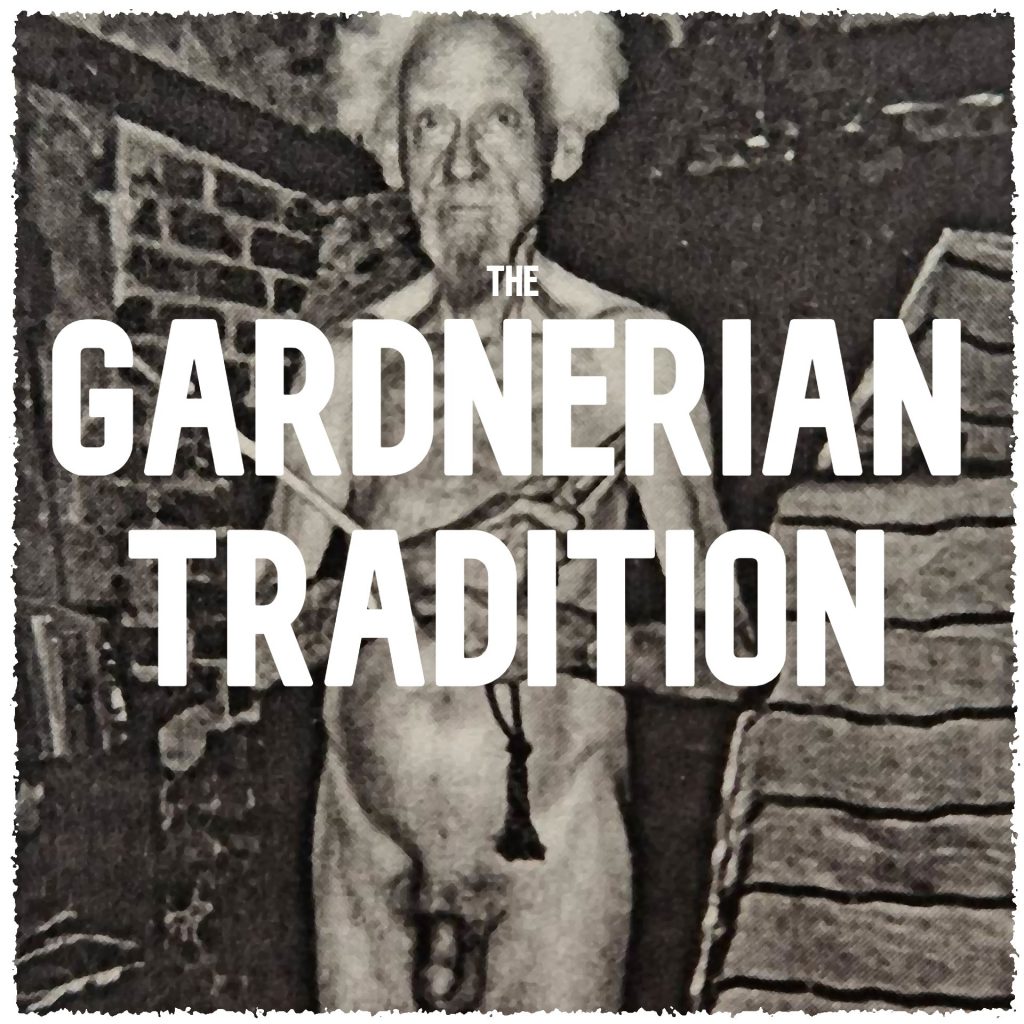The Gardnerian Tradition of British Traditional Wicca, is a modern form of Witchcraft, founded in the 1940s and 1950s in the south of England.
The Gardnerian tradition in its simplest sense focuses on the traditions, practices and rituals passed down over generations of initiates, developed and enriched by individuals such as Doreen Valiente, Patricia Crowther, Eleanor Bone, and many others, from the original work of Gerald Gardner, the New Forest Coven, and the many sources which they drew from. These traditions, practices and rituals have evolved and changed as our own magical understanding and practice has grown since the loss of Gardner in 1964. Like many of the Witch traditions that emerged after 1951 and the repeal of the Witchcraft Act, many different branches have formed over time, and there are now many different lineages and covens practicing our tradition all over the world; each with their own idiosyncrasies, philosophies, and practices. All linked by our connection and initiations of which we trace back through to Gardner and his initiates.
The Gardnerian Tradition has four main schools of thought – The Fertility religion, The Reincarnation Cult, The Esoteric Mystery Tradition, and The Witchcraft practice. Most contemporary covens will work a mixture of these with a predominate focus on the practical aspect of the Witchcraft practice.
The Fertility religion aspect of the Gardnerian tradition derived from the now debunked theories of Margaret Murry and her book Witch Cult in western Europe, which in time gave rise to the social mythology and ideology of rescuing an ancient pagan fertility religion and preserving its practices. This was a foundational belief within early Gardnerian craft and has been influential in many of the more “traditional” aspects of our tradition.
For many contemporary covens our tradition is fundamentally a Reincarnation “cult”. Gardner said in his book The Meaning of Witchcraft: “The Witches are firm believers in reincarnation, and they say that ‘Once a Witch, Always a Witch’.” And in Witchcraft Today: “The Witch remembers her last incarnation” with the claim that he quoted the text from a Witches book given to him, presumably by a member of the New Forest Coven. This belief in reincarnation has given rise to the concept that we examine to see if someone fits the pattern of the coven and if we recognize them as belonging to the Wicca!
Our tradition is also an esoteric mystery tradition, one in which the dramas of the inner world are practiced by and for the benefit of its initiates, through rituals where these mysteries are explored and deeper understood. Where we engage with the Spirits of our tradition, the Goddess of Life and Lord of Death who engage in a mythical dance outside of time and space, gender, and sex. However, for our understanding we have socially set a reduced perspective and limit upon them for our recognition, to aid us in better understanding the complexity of the unfathomable. They are Form and Void, Evolution and Involution, Subject and Object, Unity and Manifold change.
The Witchcraft of the Gardnerian tradition is our practical craft. It is the act of actualizing correspondence through prayer; meaning that we engage with the world and that which is within it and act through our beliefs to make a change. We work our rituals not to seek money, power, or fame, but to empower ourselves and those within our coven. Through Coven rituals we bring people together to help individuals feel connected to a larger purpose and gain a sense of empowerment through shared experiences. Group empowerment then always leads to self-empowerment; to take responsibility of your own life, recognizing your own strengths and weaknesses, and become confident in your abilities and believing in yourself.
Studying these four schools of thought – The Fertility religion, The Reincarnation Cult, The Esoteric Mystery Tradition, and The Witchcraft practice, can help us in understanding how other Gardnerian covens and initiates engage with our tradition. Understanding and appreciating others can help build stronger craft relationships between initiates. A stronger sense of community and a greater ability to appreciate and value the contributions of others can lead to a more positive and enjoyable life for everyone within our tradition.
A positive and supportive environment is essential for everyone to thrive.
All Gardnerian Covens have initiation ceremonies and rituals, and new coven members are always required to wait a up to the traditional Year and a day before receiving initiation to ensure they were serious and dedicated to wanting to work the tradition and its degrees. These degrees take many years to work and achieve, they are not trophies to mark a celebration, but acknowledgements of the serious work and commitment you have put into the rituals and the engagement of yourself through the Mythos and Gods.
What are the Three Degrees?
The First degree which makes you a coven member and marks you as an initiate of our tradition, giving you access to our Books of Shadows and rituals. This is the degree where you learn all core aspects of the tradition and learn within the support system of the coven, being mentored by the 2nd and 3rd degree members. On average most people spend anywhere from four to six years in this degree.
The Second degree which elevates you and acknowledges your work as an initiate, where you begin work in helping others develop and take on more responsibility in our coven, or even potentially hive off and start your own coven. This degree shows you have mastered the techniques of the tradition and are capable of self-sustained practice of the tradition, as well as a deep understanding and relationship with the spirits of our tradition.
And finally, the Third degree, which is personal advancement and inner development to a deeper understanding of all aspects of the tradition. You are fully developed as an initiate and are now fully aware of the mysteries.
The Old Religion as our tradition is called by some, is often interpreted as meaning that Gerald Gardner was rescuing a dying cult, which is a romantic view of a period of history that at that time had a contemporary interest in Nudism, Spiritualism, and an ease of access to occult materials inaccessible to the common man before. Our tradition is primarily a Craft practice and not a faith or religion. Many members of our tradition hold several personal faiths and religions: Secularism, Paganism, Hermeticism, Thelema, Satanism, and many others. Blind unquestioning Faith within our tradition is Anathema, it is against our nature as a tradition to dictate what should be believed and how an individual should live and express themselves. We work for all our initiates to come to Know themselves as individuals through the co-operative magic of coven practice.
This romantic interpretation of rescuing a dying cult combined with the onset of WWII created a period of our traditions history that was the cooking pot for the earliest ritual material of our tradition to be experimented with and ultimately worked into Gardeners Bok of Ye Art Magical, which was a precursor text to our traditions Books of shadows. The Books of Shadows, details our Mythos and Praxis which is a living breathing thing, it grows differently under different conditions, in different climates and uniquely around the world. We have this as a record of all the work and rituals done by those that have come before us in our lineages, but what we do now may not always reflect what those have done and believed before us. The Book of Shadows is a very influential but also commonplace book of rituals and records, it is not a holy text or religious document as many older initiates now treat the writings of Gardner to be “gospel” which is not how all Gardnerian coven’s work. We must acknowledge the history and times in which many of our rituals were written, times where there were unjust legal precedent and social ideology, hatred, and bigotry towards the LGBTQIA+, and POC. As a tradition we must now move onwards with a contemporary practice, reflecting modern society and its acceptance towards LGBTQIA+ initiates and those adaptations needed for their inclusion, such as “Post” gendered initiations, and the abandonment of enforced gender roles within rituals. The Gods are beyond gender enforcement and so too should we.
Our tradition works Skyclad or in other terms we wear the “seamless Garment of the Goddess”, which is to say that SHE is naked in Her Truth.
“I charge you earnestly to come before me in a single robe and covered with their rich headdress” Charge of the priestess, Gnostic Mass (AL I.61) – The “single robe” of the Nuit speech and the “No robe” of the Babe of the Abyss both relate to a spiritual condition similar to, if not identical to, nakedness – the robe is the flesh.
“And ye shall all be freed from slavery, and so ye shall be free in everything; And as the sign that ye are truly free, Ye shall be naked in your rites, both men and women also” – Gospel of the Witches.
The practice came from the Coven that Gerald Gardner himself was initiated into in 1939, and not an invention of Gerald himself. We must also recognize that at the time Gerald was initiated that Nudism and Naturism was actively being recommended by medical professional for a range of ailments. As such working Skyclad became an integral part of the idiosyncrasies of our tradition and is practiced by almost all Gardnerian covens.


